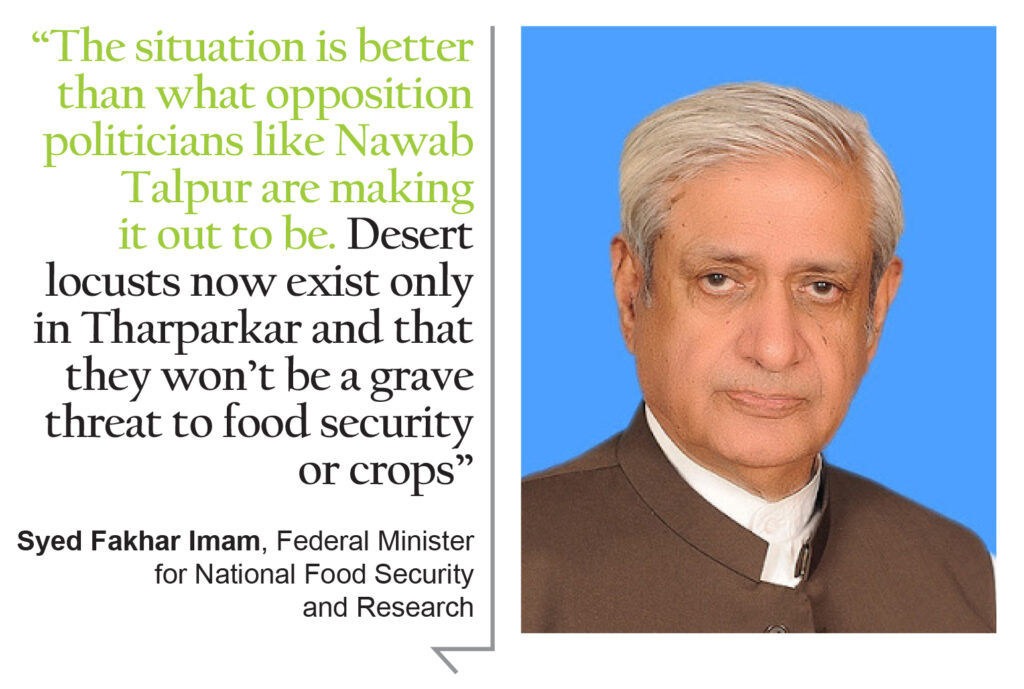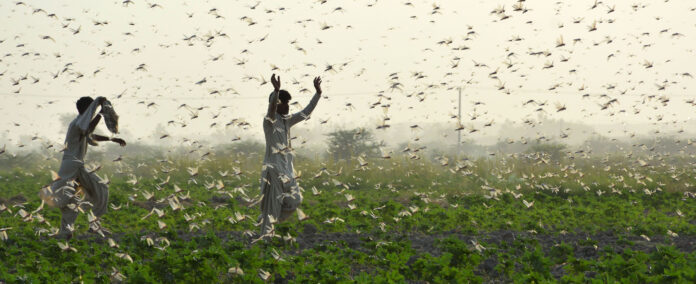The India-Pakistan border is heating up, but not in the way that you might think. After suffering through two critical waves of locust attacks that have put our food security at threat, a third wave is primed for an invasion, and this one may be the strongest.
Pakistan has been fighting a two-front battle since the breakout of the coronavirus. The global pandemic has dominated the headlines in the country, understandably so, but the critical battle against the locusts is being waged in the background.
Two different waves of the locusts have already laid havoc to crops this year alone, leaving countless farmers destroyed and financially ruined. The first wave, which actually hit before the first coronavirus cases were discovered in Pakistan in March, was mismanaged horribly. The second one was worse, mostly because the mismanagement of the first meant more locusts had bred in the time.
Now, this threat to our food security of literal biblical proportions, is coming back in the form of a full fledged third wave. According to a recent report by the Food and Agriculture Organisation (FAO), the situation remains serious along the India-Pakistan border where monsoon breeding commenced by spring-bred swarms, including those returning from northern India. Substantial hatching and band formation was expected in August. The report further stated that multiple first-generation hopper swarms and groups formed in Tharparkar near Nagarparkar and the Indian border in the extreme southeast of Sindh from earlier laying.
What does this mean? Imminent disaster. But this time, hopefully, Pakistan will go in against the locusts with experience. Critical for this will be the National Locust Control Center (NLCC), which was established back in late May during the second wave. On August 10, the NLCC lit the beacons, warning that swarms of locusts would soon attack from India and Africa. They further said that with the economy already teetering because of the coronavirus pandemic, the threat to food crops might mean a food security crisis in the country like never seen before.
The NLCC claims that the risk of the attack has been reduced from 61 districts to only two as a result of timely operations by the government. They claim the infestation has been reduced to Tharparkar and Bahawalpur only. However, these claims and the lax attitude on display are not new, and are eerily similar to the attitude that resulted in the mismanagement of the locusts attack the previous two times this year.
Will this time be any different? The NLCC’s latest daily update says it is continuing an operation in Nagarparkar and other suburb areas close to the Indian Border in South-East Sindh. As a result, there are very few adult grasshoppers present in Cholistan and Lasbela. While this is a good sign, the concern is that they may have left behind eggs.
As of Monday, during the last 24 hours, the NLCC conducted a survey of 206,200 hectares of land and carried out controlled operations on 791 hectares of land in the affected areas of Tharparkar. During the last six months the swarms have been eliminated from 1,105,400 hectares of land across the country.

This is the third wave of the locusts attacking, and this is also the third time Profit has warned the government that it needs to pay heed to the serious threat to food security that the locusts pose. Instead, the government has simply locked horns with the Sindh government instead of giving the issue the serious attention it needs. Not only does it not seem to be on the government’s priority list, it is being treated with the same attitude as most problems – turn your head and hope it goes away.
The damage done
There are no two ways about it, the scenes were devastating. Pakistan was too busy embroiled in the coronavirus crisis to notice that in March swarms stretching across miles had invaded the country from Iran. They caused destruction in Balochistan, leaving in their wake half eaten tree trunks, barren orchards, and destroyed farming families.
After feasting with no restraint, these swarms marched ahead into Punjab, and Khyber Pakhtunkhwa districts. For this first wave, despite warnings coming in from major world organizations as well as foreign and local publications, the government was caught helpless, with only one plane available for aerial spraying and no real point person responsible for the attack.
Farmers had to organise on their own and use traditional methods, such as beating pots and pans, to try and drive the swarms away. While these methods would be effective for smaller swarms, these were not normal circumstances. Control efforts were made by the Department of Plant Protection (DPP), but the swarms of locusts started moving towards Sindh and Punjab in June. This was a short moment of respite, but not for long, because the onset of the summers and the monsoons meant it was breeding season, meaning they would come again.
Locusts have attacked before as well. This, however, is unprecedented because of a mixture of abnormal weather patterns, such as excessive rains causing feast-to-eye vegetation in Tharparkar and Cholistan, that have resulted in a locust invasion of historic proportions. The FAO locust forecaster, Keith Cressman, told the Thomson Reuters Foundation that swarms in 2020 were likely to be much larger than in 2019, roughly 20 times more. A swarm, roughly 20 to 100 miles long travels 150 km (93 miles) and devours 200 tonnes of crops per day. In the African region, one swarm as long as 800 km has been spotted.
Add to this Pakistan’s climate, which is perfect for locust reproduction, and you have the FAO saying that Iran and Pakistan are especially prone. In Pakistan, 38% of the area (60% in Balochistan, 25% in Sindh and 15% in Punjab) are breeding grounds for the desert locust, whereas the entire country is under the threat of invasion if the desert locust is not contained in the breeding regions.
This has been the concern being raised from the beginning. As long as the government does not fight the breeding grounds by attacking locust eggs, the swarms will keep coming back again and again. The earlier mentioned report of the FAO actually predicted that Pakistan’s economy may suffer a whopping Rs800 billion loss altogether in summer crops such as cotton, sugarcane and rice besides fruit and vegetables.
Continued lack of action
Back in January, when the visible swarms finally made the government slouch into action, a national action plan had been devised. But the formation of this plan, which promised quick and efficient action, has barely been implemented. In fact, Nawab Muhammad Yousaf Talpur on the floor of the national assembly decried the plan as a complete failure.
“The national action plan was not implemented in true letter and spirit, and as of today, the situation is that the locusts that were supposed to go back to African have ironically taken a U-turn and returned back to Pakistan, just because our government took this issue lightly,” he said. “Unfortunately in this country, all the problems are handed over to the Army, and so is the case with swarms of locusts which were given to the National Disaster Management Authority (NDMA) to deal with.”

The speech on the floor of the house was a scathing indictment. As he explained, locusts have once again entered from Iran and are making their way through Balochistan. By the end of the month, a fresh generation will make its way across the border from India, sandwiching Pakistan in this two-pronged invasion. Soon enough after this, swarms from Africa are also expected.
“I have beens saying this for weeks. You have two helicopters and one aircraft lying idols. They must be used to deal with the swarms of locusts,” said Nawab Talpur. He also accused that the government first said that UVL medicine from China will not be sprayed on any irrigated area. “That is well and good, the irrigated areas have to be saved. But what about the desert where the locusts are the most? There are no irrigated areas there.”
Nawab Talpur claimed that when he contacted the local administration there they said locally the problem they are facing is that DPP vehicles are not available and if the vehicles are available, they don’t have the fuel to run it.
Measures taken to contain locusts
The government, of course, feels that they have done their due diligence. Federal Minister for National Food Security and Research, Syed Fakhar Imam, chaired a meeting of the NLCC held on August 7, which stressed on appropriate measures to deal with probable danger of locusts travelling from Africa and India to the country.
However, he said that the situation was better than what opposition politicians like Nawab Talpur were making it out to be. According to him, desert locusts now exist only in Tharparkar and that they won’t be a grave threat to food security or crops. However, this statement ignores the clear pattern that we have seen over this year, in which the locusts always end up travelling from desert areas exactly because the government is unable to control their spread.
“There has been a lot of progress as well,” said Fakhar Imam at the meeting. “In Punjab, 14,583,148 hectares have been surveyed and 458,960 hectares have been cleared from the swarms of locusts and our latest operation is being carried out in Cholistan. Similarly, in Balochistan, 15,932,993 hectares of land have been surveyed and 472,487 hectares have been treated. Meanwhile, KP has surveyed 8,052,726 hectares and cleared 62,335 hectares from locusts.”
In Sindh, 9,460,053 hectares are treated and 101,168 hectares are free from grasshoppers. The government is also engaging the Space and Upper Atmosphere Commission of Pakistan (SUPARCO), to use space-based information to analyse areas with reference to their suitability for desert locust habitats based on vegetation, soil type and other factors.
However, the contentious factor in all this has become the tension between the federal government and the provincial governments, particularly the continued spats between the PTI led center and the PPP administered Sindh.
Imam, while addressing the 5th meeting of the NLCC, said that the federal government was going to spend Rs14 billion, and the provincial governments will contribute Rs12 billion to contain and counter the swarms of locusts. While the FAO has appreciated the measures taken by the government, budget and political tensions have meant that the most vocal critic of the federal governments tactics has been Mir Muhammad Ismail Rahoo, Sindh’s Agriculture Minister.
The Sindh-Center spat
Rahoo made his dissatisfaction with the federal government known recently in conversation with journalists after visiting the locust hit areas in Tharparkar region. He accused the federal government of being uninterested in the eradication of locusts, and that they had miserably failed to cooperate with provincial governments, especially in Sindh to contain the scourge of the locust swarms.
“We had asked for 100 vehicles some time ago, Sindh needs this, since we are looking at a massive attack in the days to come,” he said. “But the Imran Khan-led federal government is as interested in dealing with the spread of the locusts as it was in effectively dealing with the spread of the coronavirus.” Farmer also endorsed Rahoo’s argument. Sajwal Palejo, a farmer from Tharparkar region, told Profit that his wheat crops were badly damaged in the last two spells of swarms of locust attack, and he was afraid that it would happen again if proper action was not taken.

“It seems that my crops would be damaged for the third time in this year as practically no measures are in place from the federal government to deal with this huge threat and it is my only source of income,” he said.
Meanwhile, Shahzad Rizvi, an agricultural expert from Layyah, told Profit that districts in south Punjab had similar sentiments. “The locusts are a much bigger threat than the coronavirus pandemic because it could be avoided by maintaining social distancing but there is no escape from food shortage and financial crunch being caused by the swarms of locust attack,” he said. “It is about time that the government take it seriously this time and not repeat its mistakes.”
Locust Emergency and Food Security Project
One glimmer of hope for Pakistan regarding this looming crisis has been the Locust Emergency and Food Security Project, better known as Leafs. On August 7, the Central Development Working Party (CDWP) gave their green signal to the Leafs project for lifting the local agriculture sector by combatting the locust threat. This will be the first federal agricultural project financed by the World Bank in Pakistan.
While the food ministry is responsible for the overall project implementation, with support of the provincial governments, the Department of Plant Protection (DPP), National Locust Control Centre, Food and Agriculture Organization (FAO) and National Disaster Management Authority (NDMA) will all assist on the $200 million project.
The main objective of the Leafs project is to focus on migratory, breeding, and infestation routes of desert locusts in addition to building capacity of the DPP. Perhaps most importantly in the short-run, it is going to compensate farmers on account of losses due to locusts across the country.
The livestock support programs are also part of the project, with the aim of mitigating negative impacts of desert locusts on the livelihoods of farmers besides strengthening and establishing food security and nutrition information systems.
In the meantime, however, the locust outbreak in the country will be managed by the DPP and the department will make national locust surveillance and pest management plan, threat assessment, monitoring of locust population, breeding and swarms, strategic coordination and control operations based on locust cycle.
This project could be a major success for Pakistan, but only if the government is able to save the crops currently under threat. The ground reality, however, is not looking good. A majority of experts and farmers believe that the government is, as usual, too late to the party and repeating their old mistakes.

























